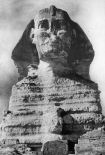Latitude 29.975350. Longitude 31.137500. Ancient site at Giza in Lower Egypt, 12 miles south-west of Cairo. The ‘Great Sphinx’, also known as ‘the Sphinx of Hamaldis’, whilst during the time of the ‘New Kingdom’ it was called ‘Horus of the Horizon’ and, in modern Egyptian Arabic ‘the Terrifying One’ – (Wikipedia). It stands just 200 metres from the Pyramid of Khafra, and is known to the local inhabitants as ‘the guardian of the Giza necropolis’. The nose of the sphinx was apparently chopped off back in the 7th century AD and, not as many historians had once thought, by the cannons of Napoleon Bonaparte’s army in 1798, but I suppose that made for a good story!
The great sphinx dates from the 4th dynasty of the pharaohs (2,575-2,467 BC) and is thought to represent Khafra, who ruled between 2,558-2,532 BC). However, some historians now think the statue might date from the New Kingdom (1,570-1,070 BC), according to author Cathal Coyle in his “very concise” article ‘Famous Landmarks’ in the magazine ‘Ireland’s Own’. This gigantic crouching limestone monument, located on the western bank of the river Nile, is 66 feet high, 63 feet wide and 220 feet in length; and has the body of a lion and the head of a human, possibly Khafra, but there is no certainty about that.
Author Cathal Coyle in his magazine article says that: “When Khafre came to power during the 4th Dynasty, he constructed the Great Sphinx by using limestone core blocks weighing hundreds of tons in his temples. His craftsmen also created more than 200 statues; 22 of these were at least three times life size.”
Coyle goes on to say: “Representative of two Egyptian gods – the pharaoh god and the lion god, the sphinx combines the body of a crouching lion with the head of a human. In ancient times, it is thought that the face and body were painted dark red and the head cloth was yellow with blue stripes.” There are said “still” to be traces of this red paint on the head of the sphinx, especially ‘it is said’ near one of the ears.
“Although there has been great speculation about the nose of the Great Sphinx, it is not actually known what happened to it. The drawings made by European travelers of the 16th and 17 centuries to Giza show the sphinx’s face complete with a nose.”
“By the time of Napoleon’s expedition to Egypt in the early 19th century, the nose was missing. One possible suggestion is that the face of the sphinx was the victim of target practice by the French army! Some scholars also believe that the sphinx originally had a beard. Pieces of the beard discovered by excavation are in the British Museum in London.”
“Much controversy has surrounded the Great Sphinx, including whether or not it was actually carved as late as the 4th Dynasty. An accumulating body of evidence, both archaeological and geological, indicates that the Sphinx is far older than this – and was only restored by Khafre duting his reign.”
Cathal Coyle goes on to add that: “Some archaeologists have also suggested that it was a memorial to a Pharaoh, but other scholars believe the Sphinx functioned as an astronomical observation device that marked the position of the rising sun on the day of the spring equinox. Later Egyptian rulers worshipped it as an aspect of the sun god, calling it Hors-Em-Akhet or ‘Horus of the Horizon.”
“What saved the Great Sphinx from complete destruction is the fact that it had been submerged beneath the desert sand for most of its existence.”
“Between 1816 and 1858, a series of adventurers, including Giovanni Caviglia and Gaston Maspero, attempted to clear the sand from around the body of the Sphinx but were each forced to abandon the project due to the enormous amount of sand. Finally, between 1925 and 1936, the French engineer Emil Baraize was successful in clearing the sand to reveal the base of the Sphinx.”
“Repairs to the Sphinx have been made over the centuries by the Pharaohs Tuthmosis IV and Ramesses II, and also during the Roman era. In the 1980’s, during a six-year period, more than 2000 limestone blocks were added to the body of the Sphinx and various chemicals were injected in the hopes of preventing the deterioration. This treatment was not successful and sadly contributed to further deterioration. The Great Sphinx at Giza continues to deteriorate because of the humidity and the ever-increasing smog from nearby Cairo.”
Author Cathal Coyle concludes his article by saying that: “The focus appears to be on preservation rather than further explorations; but towards the end of 2010 during routine excavation work in the area of the monument, Egyptian archaeologists discovered large sections of mudbrick walls which were part of a larger wall which stretched for 132 metres around the Great Sphinx.”
Sources:
Coyle, Cathal., Famous Landmarks, Ireland’s Own, (various dates), Wexford, Ireland.
https://en.wikipedia.org/wiki/Great_Sphinx_of_Giza


